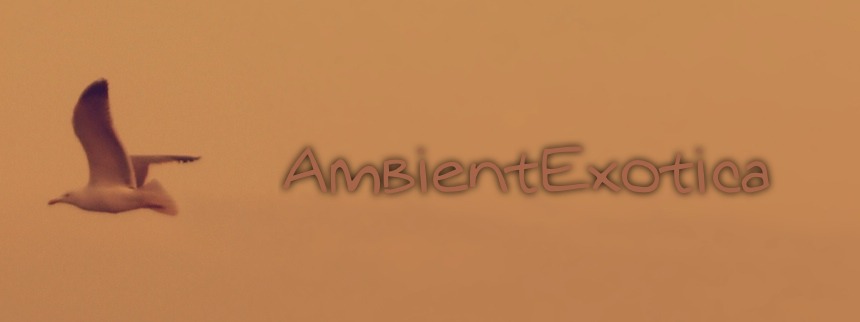
Mendel Kaelen
The Tragedy That
Drowned Itself
2012
If The Penguin Orchestra had not released an album called Music For A Found Harmonium, chances are good that the Netherlands-bred, London-based Ambient musician Mendel Kaelen, who asked me to review his latest work, would have come up with a similar title, as it describes the intrinsic soundscape of his second full-length album perfectly. Actually called The Tragedy That Drowned Itself, its five tracks are based on one specific nucleus: a cranky Indian harmonium. This is not exactly the most beautiful instrument one might think of, but mind you, it provides a great source for delicate drones. You can only do so much with one single instrument, so Kaelen is forced to be creative and thus adds a variety of noises and field recordings as accompanying layers. In addition, the harmonium is, at least to my mind, heavily processed, filtered, altered, pinched and twisted, resulting in various tonalities and timbres, be it vibrating drone layers, mystified outbursts or gorgeously galactosamine cyberbird-resembling chirping sounds. Do not pay too much attention to the album title, as it implies vignettes of mourning and an overall sadness. These gloomy thoughts, however, are nowhere on this album. Or alternatively – just to put the album title into perspective anyway – the tragedy really has already drowned itself and leaves anything but a certain loneliness and nothingness on the one hand, and a resplendent harmony spiced with moments of happiness and content on the other. To round off these thoughts, look at the album cover, as it seems to show the gradual, well, gradient which links back to the similarities of the five different tracks, but also shows their differences. I will explicate my thoughts more detailedly below, but let me place one last relative clause at the end of this opening paragraph in order to put things into perspective: if Mendel Kaelen did not stress the fact that the soundscape is built with the help of one single instrument in addition to a few complemental crackles and field recordings, I would not have been able to pinpoint this fact.
The point of origin to Mendel Kaelen's endemic Dronescape is called The Cloud, and at first, everything seems perfectly normal: a slow and hazy fade-in phase full of blizzardous wind gusts, liquedous crackles, wooden creaks and the distant monotony of sine waves reminds much more of the field recordings of Chris Watson or the mild-mannered material of Francisco López rather than the prospect that is given by Kaelen himself. And yet there it is! After approximately two and a half minutes, the first tone burst of the Indian harmonium cuts through the thermal wideness, but keeps a low-profile otherwise. As positively gimmicky as this instrument is for this release, at least The Cloud is ultimately about the entanglement of different kinds of winds and storms. Even the spectrally stretched legato tones of the harmonium are only embedded here in order to accentuate the winds, not vice versa. Their inclusion furthermore adds traces of New Age manners to the mix, but, please excuse the worst of all puns, they are literally gone with the wind. The plasticity of The Cloud is remarkable, the listener is fully immersed by the aerial loftiness, and the plasticity of the blebs and splinters nurtures the process of encapsulation only further.
After the dark belly-massaging Drone-related windless lead-out section, The Stream follows next, and it is here that the harmonium is used more prominently, as it is placed next to an empty nothingness. There is no carved out backdrop. Whisper-quiet harmonium tones gyrate round vinyl-resembling crackles and similarly wooden clicks, forming a lacunar structure through which the echoey Space-Age bumblebee drones of the harmonium ooze eerily. The Stream encompasses one of the biggest strengths of the genre in that it takes all the time it needs without ever changing the soundscape forcefully. The duration of over eleven minutes provides a graceful tranquility, especially so when the vault-like harmonium tones mesh with their warmer, crunchier counterparts. Fans of the minimalistic school of electro-acoustic music will relate. Almost 20 minutes of runtime are reserved for The Horse, and it is here that Mendel Kaelen enters proper Drone territory, as this tune gleams and glints in technicolor, fully immersing the listeners in thermal heat and ethereal warmth. Launching with strange buzzes, bonfire-like crackles and a droning but non-threatening darkness, the drones of the harmonium brighten up after about two minutes already, injecting snugness and an aura of contentment to the mix. But it is getting better: the stylophone-esque timbre of the tone sequences is altered further and culminates many times into a euphoria that could not possibly build beforehand due to the ensuing minimalism. While you cannot hum along to the melodies, The Horse offers a wonderfully enchanting song structure that resembles Brian Eno's earliest works as well as the Japanese majesty of Tetsu Inoue's backing synths. The shifting warmth, the euphony and the ubiquitous gentleness of the various noises and slivers even remind in large parts on Simon Scott's 2012 opus Below Sea Level. It is the second-most accessible track Kaelen created for his sophomore album.
Up next is The Heart, an ever-changing Drone track with various phases: kicking things off with a granular mist of foggy pulses, enigmatic footsteps on a wooden floor and approaching windstorms akin to the opener, the arrangement soon enters its bubbling segue with scattered piercing harmonium tones encoated in a grey emanation. Everything is misty on this track, only the dry and sudden bass drones resemble a darker, potentially uneasy force. The third phase consists of a potpourri of sumptuous drones that tranquilize the listener with their purposeful monotony. The sine waves float by, among them a terrifically abyssal bass layer which works all the better when the winds fade out and there is anything else but the drones. The farther the composition progresses, the cozier its results become, as Kaelen delivers infusions of manifold bass layers. Both the electro-acoustic and the Drone genre are perfectly realized with this overtly minimal yet fully fleshed out, vibrating force. The auspiciously titled The Dream is the final track. And what shall I say – it perfectly transforms the title into sounds. If I were only allowed two words to describe it, these would be ethereality and rapture. The beginning of this track is based on two or three thin harmonium strings in unison, but even this almost whimsical ebb and flow of their aural nature is absolutely beautiful and euphonious, inheriting a peacefulness and balmy power that is aptly accompanied by chirping harmonium birds whose decay conflates with the gorgeous mélange. The sounds are pristine, almost purified, the short cameos of gurgling rivers are blissful, the chirping harmonium seemingly unreal. There is one track where my amazement about the harmonium-based sounds grows sky-high, and it is this final outing which sounds fuller and more complete near its end, as added bass drones boost the plasticity. A superb outro and the signature track of The Tragedy That Drowned Itself. Or is it?
To answer the final question of the previous paragraph, it depends on your viewpoint, as Mendel Kaelen's sophomore album features five tracks with a decisively different focus despite their overarching feature they have in common, namely that Indian harmonium. Whether you prefer a field recording-based windscape with infinitesimal harmonium flecks, a structure of emptiness where the little sounds whirr and float seemingly unperturbed, or a Pop Ambient construction with a euphorious good-natured mélange of well-texturized streams and stretched washes, The Tragedy That Drowned Itself has them all, even though its deliberate shortcomings suggest otherwise. It is in fact so tremendously varied and languorous even in its mystified surroundings that it is hard for me to link the cryptic album title to any of the five compositions. There is no tragedy attached anywhere nearby. The Dutch artist does his best to not reuse either the texture or the dynamics of the Indian harmonium. It does sound differently every time, and once this is not the case, the surroundings differ enough to let the instrument work on another level. Rest assured though that Kaelen never puts the instrument too much upfront in the mix. It is usually as important as the clicking vesicles, popping cuts and the field recordings. However, there are indeed times where the harmonium proves to provide the sole audible source of sound waves as depicted in the later stages of The Heart; it is then all about the most poignant, clearest form of Drone music. The Tragedy That Drowned Itself is a strong work that shows the powers of post-processing and good field recordings, true, but the overcoming of the limited concept itself – gentle melodies and arcane tones deriving from one instrument only – is the hardest part, and it seems to me that Kaelen eliminated this narrowing factor with ease. The long durations further allow the sounds to unfold. A great depiction of minimalism which is skillfully camouflaged.
Further listening:
You can listen to excerpts and occasionally complete runs of all five tracks on Mendel Kaelen's SoundCloud page.
Update Dec. 3, 2012: Shortly after publishing the review on November 28, Mendel Kaelen contacted me via email to stress one thing I could not ever have imagined heretofore, even though the press sheet attached to his release stated just that: The Tragedy That Drowned Itself comprises of anything else but the various tones, drones and flecks coming out of this Indian harmonium! Yes, even the chirping sounds, the hazy synth (!) washes and the distant mellow aura. Of course they are processed and altered, but their sole existence always derives from the harmonium as their original point of departure. I know that guitars and other stringed instruments can offer boundless of timbres and colors, but I did not have the harmonium on my radar. My original review as seen above will not be updated. My false perceptions boost the qualitative signs and the vivacious textures of the album even further, they really are this life-like. Mendel Kaelen got me fooled and flummoxed, and I for one am all the more impressed by his erudite soundscape!
Ambient Review 153: Mendel Kaelen – The Tragedy That Drowned Itself (2012). Originally published on Nov. 28, 2012 at AmbientExotica.com.
